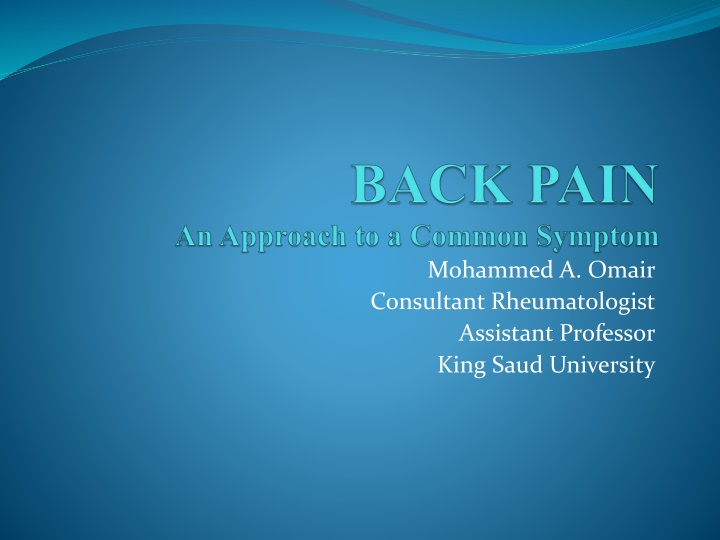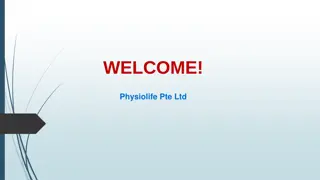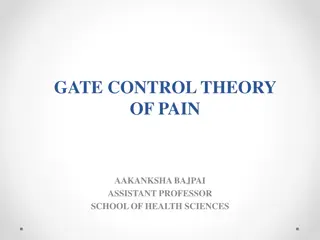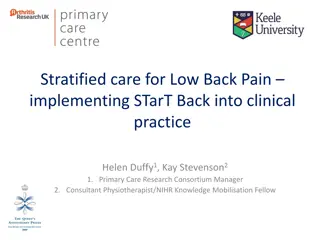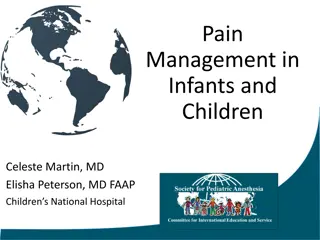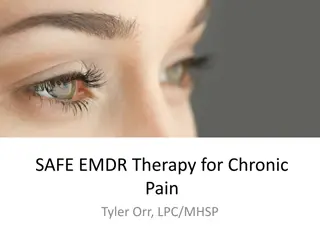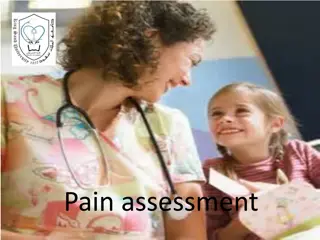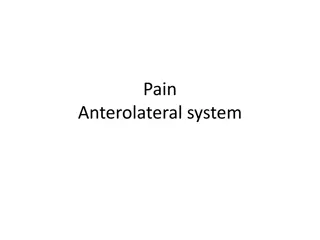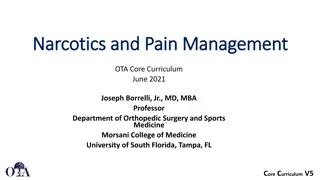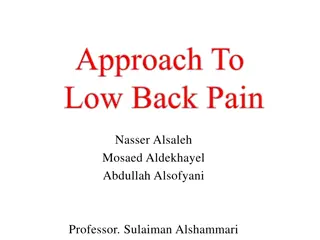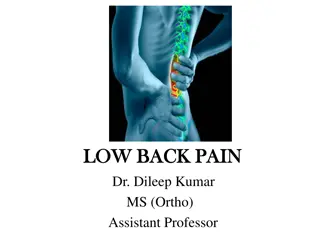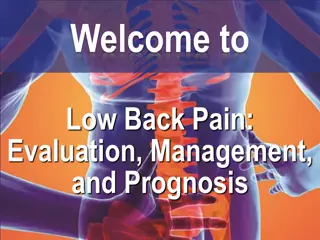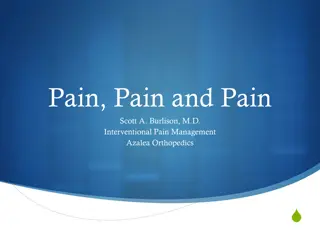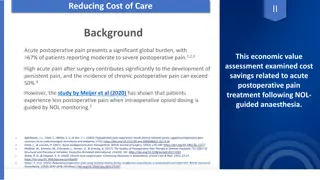Managing Low Back Pain: A Comprehensive Approach for Different Patient Profiles
Low back pain is a common reason for physician visits, with significant economic impact. This presentation by Mohammed A. Omair, a consultant rheumatologist and assistant professor, focuses on recognizing common causes of low back pain, identifying key features for diagnosis, and discussing real cases. Different patient profiles are presented, highlighting the importance of tailored management strategies and avoiding unnecessary interventions. The content emphasizes the significance of a systematic approach and adherence to clear guidelines in managing low back pain.
Download Presentation

Please find below an Image/Link to download the presentation.
The content on the website is provided AS IS for your information and personal use only. It may not be sold, licensed, or shared on other websites without obtaining consent from the author.If you encounter any issues during the download, it is possible that the publisher has removed the file from their server.
You are allowed to download the files provided on this website for personal or commercial use, subject to the condition that they are used lawfully. All files are the property of their respective owners.
The content on the website is provided AS IS for your information and personal use only. It may not be sold, licensed, or shared on other websites without obtaining consent from the author.
E N D
Presentation Transcript
Mohammed A. Omair Consultant Rheumatologist Assistant Professor King Saud University
Objectives To recognize the most common causes of low back pain To identify key features in history and examination which direct to the right diagnosis To identify red flags To discuss real cases and there complains Initial management of back pain
Case Study Mona is a 28 years old lady with back pain. Tahani is an 18 years old lady with back pain. Hessa is a 45 years old lady with back pain. Saleh is 35 years old man with back pain. Aziza is 60 years old lady with back pain. Helena is 40 years old lady with back pain. Aisha is a 92 years old lady with back pain.
Same complain/Different Etiologies Site Duration Pattern Severity Relieving/aggravating factors Associated symptoms Neurological deficit Affection on activity and quality of life Occupation Past medical/surgical history
Introduction Low back pain is one of the most common reasons for visits to physicians in the ambulatory care setting. The total cost related to back pain, both direct and indirect, is estimated to be >$100 billion per year in the U.S. If approach is not systematic cost/identification of non- clinically significant lesions/worsening of psychological condition will all be affected. Katz et al. J Bone Joint Surg 2006;88:21-4
Introduction Types of patients with back pain seen in the A&E, primary care, neurology, neurosurgery, orthopedic, rheumatology are different. Guidelines of the American College of Radiology are clear, safe and simple to follow. Forseen et al. J Am Coll Radiol 2012;9:704-712.
Non Specific Back Pain Is not associated with significant functional impairment or rapidly progressive neurologic deficits. Paracetamol/Muscle relaxants NSAID s Opioids Referrals for physical or occupational therapy may also be considered. Imaging and invasive interventions are not recommended at this stage
Non Specific Back Pain Follow Up After 4 weeks If there is improvement, educational materials are provided, and instructions on self-care are reinforced. Referrals for physical therapy, occupational therapy can be suggested. If no improvement, with no red flags or radiculopathy/Spinal stenosis, imaging with MRI may be recommended.
Radiculopathy Radiculopathy is defined as nerve root dysfunction manifesting as pain, paraesthesia, reduced sensory function, decreased deep tendon reflexes, or weakness. It is not a cause of back pain; rather, nerve root impingement, disc herniation, facet arthropathy, and other conditions are causes of back pain The onset of symptoms in patients with lumbosacral radiculopathy is often sudden and includes LBP.
Radiculopathy Preexisting back pain may disappears when the leg pain begins. Sitting, coughing, or sneezing may exacerbate the pain, which travels from the buttock down to the posterior or posterolateral leg to the ankle or foot.
Spinal Stenosis Progressive narrowing of the spinal canal may occur alone or in combination with acute disc herniations. Neurogenic claudication: Pain, weakness, and numbness in the legs while walking. Onset of symptoms during ambulation is believed to be caused by increased metabolic demands of compressed nerve roots that have become ischemic due to stenosis. Pain is relieved when the patient flexes the spine Flexion increases canal size by stretching the protruding ligamentum flavum, reduction of the overriding laminae and facets, and enlargement of the foramina.
Radiculopathy and Spinal Stenosis Patients in this category can be managed conservatively such as the non specific. Not because it is not serious, but because there is no strong evidence for doing other modalities.
Radiculopathy and Spinal Stenosis Follow up Patients should be assessed for: Depression Coping Psychosocial support If improved, educational materials are provided, and instructions on self-care are reinforced. If no improvement, Pain service/Psychiatry/Neurology consult MRI as the imaging modality
Red Flags Their presence indicate the possibility of a serious underlying condition, such as malignancy, vertebral infection, vertebral compression fracture, cauda equina syndrome, and ankylosing spondylitis. Depending on the condition, early referral to the appropriate specialty has a major impact on the outcome. There is a role of lumbosacral X-ray
ParaspinalAbscess Acute paraspinal infections are most commonly bacterial while subacutecould be anything. (staph Aureus, E. Coli, TB, Brucella). Localized back pain is the 1stsymptom. Fever, chills, night sweats Hematogenousspread with seeding is the suspected source of infection in young. Primary source includes bacterial endocarditis, IV drug use, infected catheters, UTI, and others. If subacuteask about TB or brucella risk factors.
ParaspinalAbscess There is usually limited motion of the spine that is affected, and movement typically produces severe muscle spasms. Compression of the spinal cord or the caudaequina can lead to paralysis or varying degrees of weakness, numbness and bladder dysfunction.
Ankylosing Spondylitis and other SpA Inflammatory back is characterized by: - Young age - Early morning stiffness - Back pain worse in the morning improves with activity. - Nocturnal back pain - Alternating back pain - Dramatic response to NSAID s - Presence of symptoms suggestive of SpA (psoriasis, IBD, and preceding infection)
AS and SpA Examination will reveal restricted movement of the whole spine with a positive schober test (<20cm). Pressure and stretching of the sacroiliac joint will induce significant pain. Presence of peripheral arthritis and/or dactylitis
Cauda Equina Syndrome It refers to a characteristic pattern of neuromuscular and urogenital symptoms resulting from the simultaneous compression of multiple lumbosacral nerve roots below the level of the conus medullaris. Symptoms include low back pain, sciatica, saddle sensory disturbances, bladder and bowel dysfunction, and variable lower extremity motor and sensory loss. This is a surgical emergency
Case Study Mona had multiple myeloma. Tahani had scoliosis. Hessa had Tuberculosis. Saleh had Ankylosing spondylitis. Aziza metastatic breast cancer. Helena was malingering. Aisha had an osteoporotic fracture.
